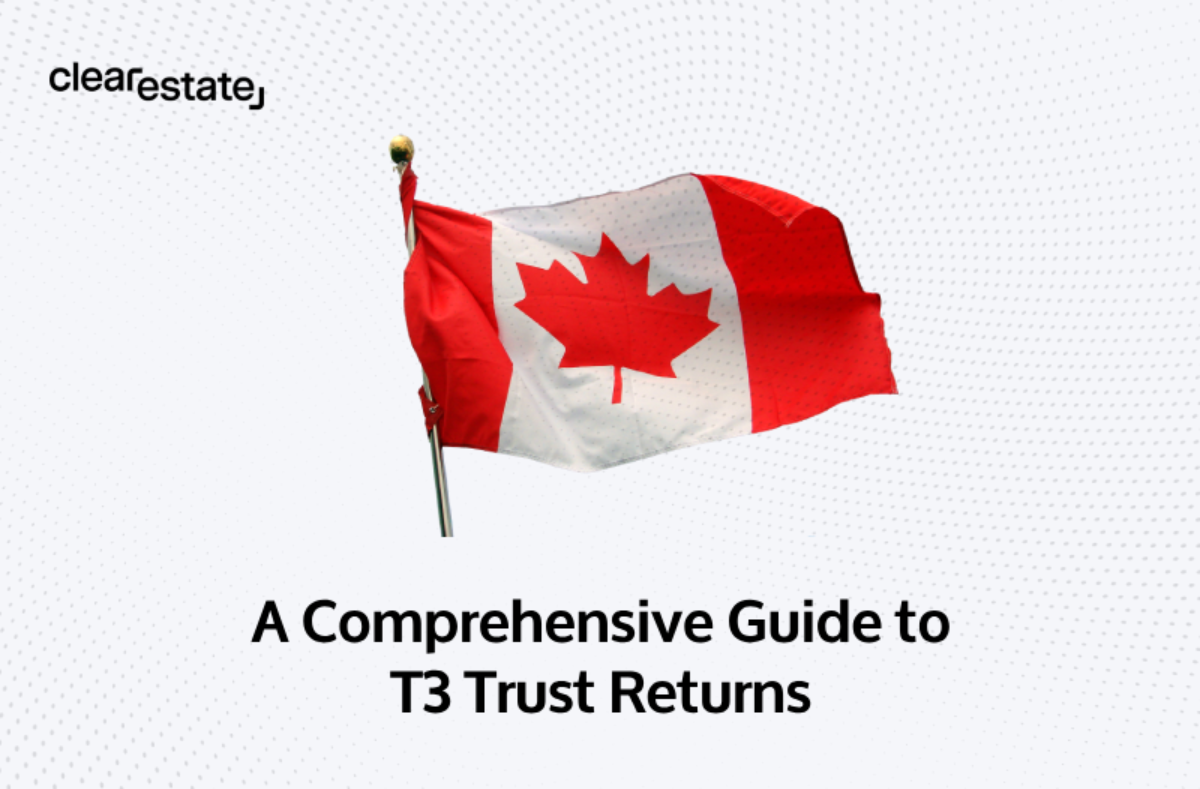Estate Settlement
Dec 04, 2024
How Do Executors Mail Inheritance Checks?
Find out how inheritance checks are mailed, including security measures and what to do if there are delays in receiving them.
Discover the T3 trust guidelines, filing processes, and new 2025 reporting requirements in our in-depth guide.


T3 Trust Income Tax Returns, or T3 Trust Returns, are a key component of Canada's tax reporting system. T3 Trust Returns are legal documents designed specifically to report the financial information of a trust such as income, deductions, and allocations to the Canada Revenue Agency (CRA).
Notably, the CRA has recently implemented significant changes to the reporting system for trusts. Effective for trusts with a taxation year ending after December 30, 2023, all trusts, with certain exceptions, are now required to provide an annual T3 Return meaning trusts that may not have previously been required to file, will be filing for the first time this year.
By having a better understanding of Canada’s T3 Trust Returns, you can be sure that you are compliant with CRA reporting requirements and don’t inadvertently face potential consequences for non-compliance. This comprehensive guide aims to provide an in-depth understanding of T3 Trust Returns, covering the definition, purpose, recent changes, and the fundamental aspects of these returns. This guide caters to trustees, beneficiaries, and settlors, offering valuable insights into the intricate world of trust taxation in Canada.
Trusts, as legal arrangements, involve the management of assets by a trustee for the benefit of specific individuals or entities known as beneficiaries. Similar to individuals reporting income tax, trusts are required to submit a T3 Trust Return. The primary objective of this return is to calculate the taxable income of the trust, ensuring accurate distribution to each beneficiary. The T3 Trust Return facilitates precise reporting of both financial income and information, playing a pivotal role in the transparent and accurate management of a trust's financial affairs, serving as a comprehensive overview of the trust.
A key reporting requirement of a T3 Return is the Statement of Trust Income Allocations and Designations or T3SUM Summary. The T3SUM is submitted alongside the T3RET, T3 Trust Income Tax and Information Return. The T3SUM provides a concise overview, while the statement and schedules offer detailed breakdowns of income and allocations.
Alongside these forms, a trust must file a T3 Slip, Statement of Trust Income Allocations and Designations, a document that outlines beneficiaries and their allocated income. The T3 Slip is not required if beneficiaries receive less than $100 allocated in the year. Depending on the complexity of the trust and its financial activities, additional schedules may be attached to provide further details. These schedules can include information on specific transactions, capital gains, foreign income, and other relevant financial aspects.
It is crucial for all trusts, other than “Listed Trusts” to complete Schedule 15 – Beneficial Ownership Information of a Trust, which collects information about beneficiaries. Various types of trusts are required to file T3 Returns such as bare trusts, express trusts, and testamentary trusts The CRA has provided an extensive guideline for users available directly online for more clarity on the different types of trusts in Canada and provides more detailed reporting information. Trustees need to grasp the specific requirements for each trust type to ensure accurate and compliant reporting.
As aforementioned, changes since 2023 bring about updated disclosure requirements, impacting how trust information is reported to the CRA.
The focus is on providing additional details about the trust, its beneficiaries, and specific transactions to enhance transparency and compliance. The primary changes includes trusts that are either:
Receives income, gain, or profit from the trust property allocated to one or more beneficiaries, and the trust has:
Trustees are now required to provide more comprehensive information, including details on settlors and beneficiaries. Beneficiaries, on the other hand, have an added responsibility—they must report income allocated to them from the trust in their personal tax returns. Remember that these changes extend the reporting obligations to trusts that may not have been previously required to file, including bare trusts.
Trustees are required to disclose information about the settlor(s), who established the trust, meaning that although their direct reporting requirements may be limited, settlors play a crucial role in providing necessary information to trustees for accurate reporting.
Trustees of testamentary and inter-vivos trusts with taxable income must file T3 Returns by the filing due date for the trusts year-end, which vary depending on the type of trust.
The T3 Return filing deadline should be no later than 90 days of the trust’s year end and should include payments for any balance owing.
In general, if the person filing the T3 Trust Return has not received all relevant information slips, the income can be estimated. Should differences occur between the estimations and the information slips received at a later date, the trustee must file for Reassessment and submit the documents to the CRA. More information on when to file can be found in the CRA Guideline.
Include the trust deed, financial statements, and supporting schedules and forms. Thorough documentation is the foundation of accurate reporting. Compile accurate financial statements reflecting the trust's income, deductions, and allocations. Depending on the trust's complexity, gather any additional schedules providing details on specific transactions or financial activities.
Complete the T3RET T3 Trust Income Tax and Information Form, the T3SUM Summary of Income Allocations and Designations, and T3 slip, Statement of Trust Income Allocations and Designations. Other important forms relevant to specific trusts that must also be included with the T3 Trust Return can be found here.
File your T3 Return either electronically through approved channels or by traditional mail. Opting for electronic filing is highly recommended for swift processing, and it is imperative to adhere to submission guidelines for a successful filing experience. For individual personal income tax and beneficiary information, you can conveniently access and view details through a MyCRA Account.
To file and submit a T3 Trust Return efficiently, consider using a My Trust Account. This platform provides trustees and authorized representatives of the trust with access to file, view, and edit trust information, streamlining the overall process. Note that T3 Slips must be filed digitally if more than 5 are being submitted and can be done through web forms.
When filing a trust return electronically - a trustee/executor/or administrator is required to apply for a trust account number which can be done directly through the CRA: here
Although specific deadlines are determined by the trust's taxation year-end, typically within 90 days after the end of the trust's fiscal period, it is crucial to understand the possible penalties related to late filing, failure to file, or filing with inaccurate information.
Failure to submit a T3 return on time incurs a late-filing penalty. This penalty is 5% of the unpaid tax at the filing deadline, plus an additional 1% for each full month of delay, capped at 12 months. For cases involving a previous late filing, the penalty may rise to 10%, with 2% added for each subsequent month, up to a maximum of 20 months. Trusts with no taxes due face an alternative penalty of $25 per day, ranging from $100 to a maximum of $2,500. Additional penalties may apply if the trust knowingly fails to file, especially if it's not a listed trust.
For false statements or omissions, non-listed trusts may incur penalties equal to the greater of $2,500 or 5% of the highest fair market value of trust property during the year. A further penalty may apply, ranging from $100 to 50% of the understated tax related to the false statement or omission. Listed trusts face penalties of $100 or 50% of the understated tax and overstated credits.
Failure to distribute or file trust-related information slips on time can result in penalties of $25 per day, with a minimum of $100 and a maximum of $2,500. Conviction for not filing a T3 return or slip can lead to fines ranging from $1,000 to $25,000 or imprisonment for up to 12 months. Starting January 1, 2024, trusts filing more than 5 information returns of the same type must file electronically. Failure to do so incurs penalties based on the number of incorrectly filed returns, with each slip considered an information return.
In essence, timely and accurate submission of T3 Trust Returns is vital for trustees, beneficiaries, and settlors, especially in light of recent changes in reporting standards emphasizing transparency and compliance. Given the intricate nature of trusts, seeking professional guidance is strongly recommended.
Book a free consultation with us today, so you don't have to navigate the T3 trust return alone.
 Simplify Probate Today
Simplify Probate Today
Get expert guidance from our probate specialists who've helped 10,000+ families.
Book a free consultation today